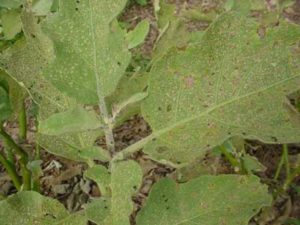Flea Beetles: Tiny Menace in the Vegetable Garden
go.ncsu.edu/readext?656986
en Español / em Português
El inglés es el idioma de control de esta página. En la medida en que haya algún conflicto entre la traducción al inglés y la traducción, el inglés prevalece.
Al hacer clic en el enlace de traducción se activa un servicio de traducción gratuito para convertir la página al español. Al igual que con cualquier traducción por Internet, la conversión no es sensible al contexto y puede que no traduzca el texto en su significado original. NC State Extension no garantiza la exactitud del texto traducido. Por favor, tenga en cuenta que algunas aplicaciones y/o servicios pueden no funcionar como se espera cuando se traducen.
Português
Inglês é o idioma de controle desta página. Na medida que haja algum conflito entre o texto original em Inglês e a tradução, o Inglês prevalece.
Ao clicar no link de tradução, um serviço gratuito de tradução será ativado para converter a página para o Português. Como em qualquer tradução pela internet, a conversão não é sensivel ao contexto e pode não ocorrer a tradução para o significado orginal. O serviço de Extensão da Carolina do Norte (NC State Extension) não garante a exatidão do texto traduzido. Por favor, observe que algumas funções ou serviços podem não funcionar como esperado após a tradução.
English
English is the controlling language of this page. To the extent there is any conflict between the English text and the translation, English controls.
Clicking on the translation link activates a free translation service to convert the page to Spanish. As with any Internet translation, the conversion is not context-sensitive and may not translate the text to its original meaning. NC State Extension does not guarantee the accuracy of the translated text. Please note that some applications and/or services may not function as expected when translated.
Collapse ▲Flea beetles are a voracious group of early-season pest we battle in vegetable gardens. There are several species of these shiny, oval-shaped 1/10” long beetles, each enjoying their preferred vegetable in the garden. Flea beetle populations are higher following a warm winter, and damage is more severe during hot and dry conditions. The crucifer flea beetle (Phyllotreta cruciferae) affects plants in the Brassicaceae or cabbage family, preferring turnips, mustards, and arugula over those with waxy cuticles, like kale. Adults feed on leaves and stems, leaving small round holes that heal with a silver cast. The damage can make eating them unappealing and reduce yield. Early plantings are most affected as adults emerge from overwintering with a voracious appetite. Eggplant is another frequent victim – damage can stunt small plants severely. Flea beetles are also common on potatoes and sweet corn. Robust well-established plants may not experience yield reduction.

Eggplant flea beetle shot-hole damage. Image by Debbie Roos, N.C. Cooperative Extension
Flea beetles are best managed with a combination of cultural practices and physical barriers. Establish fall brassicas away from spring plantings, and rotate crops regularly. Place row covers or insect netting over susceptible crops to exclude emerging flea beetles. Set out larger, rather than smaller transplants. Transplant eggplant into black plastic mulch or landscape fabric to speed up establishment. Ensure plants have adequate water and fertility during establishment. Consider fertilizing damaged plants to help them through. Protectants such as kaolin clay (Surround®) can also be used to deter flea beetles. Consult your local Cooperative Extension Center for chemical recommendations, as several effective options are available.



